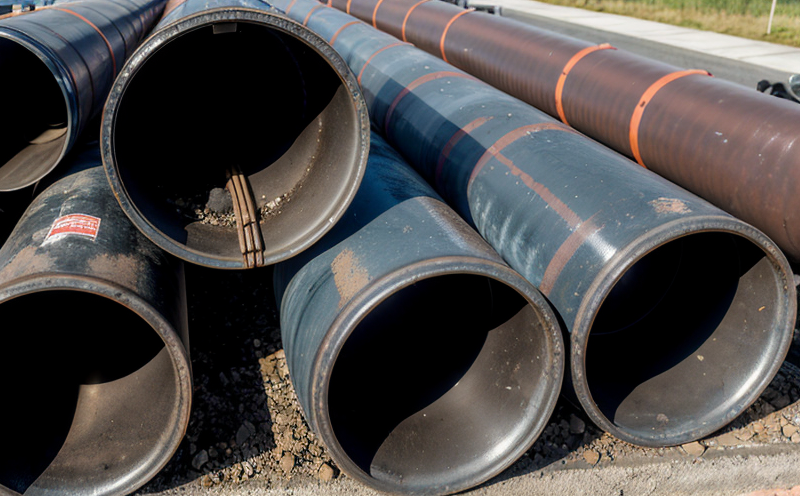ASTM D1599 Burst Pressure Testing of Plastic Pipes
The ASTM D1599 burst pressure testing method is a critical procedure used to evaluate the integrity and performance characteristics of plastic pipes under hydrostatic pressure. This service ensures that pipes can withstand the expected operational pressures without failure, thus enhancing safety and reliability in various applications.
In industries such as water distribution, wastewater management, irrigation systems, and chemical transport, ensuring the structural integrity of plastic pipes is paramount. ASTM D1599 provides a standardized approach to test these materials by subjecting them to progressively increasing hydrostatic pressure until failure occurs. This service supports compliance with international standards and helps manufacturers and engineers make informed decisions regarding material selection and design.
The burst pressure test measures the maximum internal pressure that a pipe can sustain without failing under controlled laboratory conditions. This is particularly important for ensuring that pipes installed in critical infrastructure meet the required safety standards. By performing this test, we help our clients identify potential weaknesses early on, thereby minimizing risks associated with premature failure.
The testing process involves several steps to ensure accuracy and consistency. Specimens are prepared according to ASTM D1599 specifications, ensuring that they represent real-world usage conditions as closely as possible. Once ready, the specimens are subjected to hydrostatic pressure using specialized equipment designed to monitor and control the applied force accurately.
After reaching a predetermined holding time at each test point, any changes in dimensions or leakage indicate failure. Failure data is then used to determine the burst strength of the pipe material, which serves as an important indicator of its quality and suitability for specific applications.
The results from ASTM D1599 testing are valuable inputs into product development cycles, helping R&D teams refine their designs based on empirical evidence. Additionally, they support regulatory compliance efforts by providing objective data that can be used to demonstrate adherence to relevant standards.
Our expertise in conducting ASTM D1599 tests ensures that clients receive reliable and accurate results every time. With years of experience in this field, we have developed a robust methodology that consistently delivers high-quality outcomes. This service not only meets but exceeds industry expectations, ensuring that our clients stay ahead of the curve when it comes to quality assurance.
By leveraging ASTM D1599 burst pressure testing, organizations can improve their overall operational efficiency while reducing maintenance costs and downtime associated with unexpected failures. In today's competitive landscape, maintaining a strong focus on quality is essential for long-term success.
Scope and Methodology
| Parameter | Description |
|---|---|
| Test Specimen Preparation | Specimens must be cut to standard lengths and cleaned thoroughly before testing. |
| Hydrostatic Pressure Application | Pressure is applied gradually until failure occurs, typically over a period of 10 minutes. |
| Holding Time | The specimen remains under pressure for at least five minutes before assessing for any changes. |
| Data Collection | Changes in dimensions or leakage during the holding time indicate failure. |
| Burst Strength Calculation | The burst strength is calculated based on the maximum internal pressure sustained by the specimen. |
The methodology outlined above ensures that all tests conducted adhere strictly to ASTM D1599 guidelines, guaranteeing consistent and accurate results. Our laboratory adheres rigorously to these procedures, ensuring that every test meets the highest standards of accuracy and precision.
Environmental and Sustainability Contributions
The use of plastic pipes in various applications has significant environmental benefits due to their durability, low weight, and resistance to corrosion. By employing ASTM D1599 burst pressure testing, we contribute positively towards reducing waste and promoting sustainable practices within the industry.
Plastic pipes are often preferred over metal alternatives because they require less energy during production and have longer lifespans, leading to reduced resource consumption throughout their lifecycle. Additionally, proper testing ensures that these materials perform optimally under challenging conditions, extending their useful life further still.
The rigorous quality control measures provided through ASTM D1599 testing play a crucial role in minimizing waste by preventing the deployment of substandard products into service. This not only enhances public safety but also promotes responsible stewardship of resources, aligning with broader sustainability goals.
Use Cases and Application Examples
- Water Distribution Systems: Ensuring that pipes used in water distribution networks can withstand high pressures without bursting is vital for maintaining reliable supply chains.
- Irrigation Systems: Accurate burst pressure testing helps optimize the design of irrigation systems, ensuring efficient use of resources while minimizing environmental impact.
- Chemical Transport: In industries handling hazardous chemicals, it's crucial to select pipes that can safely transport fluids without posing risks to human health or the environment.
- Sewage and Wastewater Management: Properly testing plastic pipes for burst pressures ensures they can handle the harsh conditions present in sewage systems effectively.
In each of these applications, ASTM D1599 burst pressure testing plays a pivotal role. It provides critical insights into how different materials behave under stress, allowing engineers and designers to make informed choices that balance performance with sustainability.





